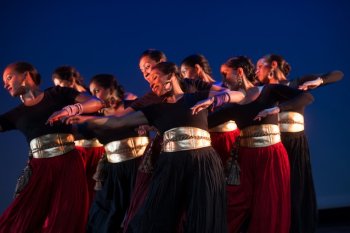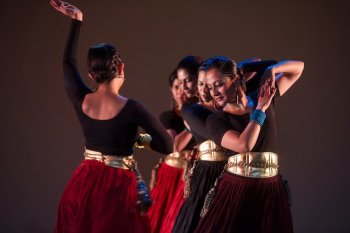
|   |

|   |
In appreciation of dance - Urmika Devi Photos: © Jacques-Jean Tiziou / jjtiziou.net July 11, 2012 (Unsung Arrivals was presented on June 22 and 23, 2012 at the Painted Bride Theater in Philadelphia, PA)  Unlike the typical dance company, Courtyard Dancers is comprised of engineers, doctors, bankers, lawyers, scientists, teachers and students. As noted in the program notes, for them, dancing is not just a hobby but “a form of critical social engagement.” For the past three years, the group has regularly produced works on contemporary and historical issues under the choreographic direction of Dr. Pallabi Chakravorty, Acting Director of Swarthmore College’s dance program and the Philadelphia region’s only Kathak teacher. The highlight of the evening was ‘Unsung Arrivals’ featuring nine students accompanied by Aqeel Bhatti (tabla), Joel Rehmat (vocal and harmonium), and Chakravorty (vocal support). Kathak is, at essence, a storytelling tradition intermixed with pure technical dance movement. The program explains that the story is of the “veiled and unacknowledged.” Who are these veiled and unacknowledged? The “who” is left for the audience to decide; yet there is a persistent feeling of loneliness, of a person left behind, which was eloquently expressed by Palak Singhee’s earnest facial expression and delicate movements. We felt her yearning and grief amidst the solidarity of remaining dancers: at times they support her, and at other times, they are a wall against her. This emotional undercurrent was underscored by Matt Sharp’s shadowy lighting, particularly the final moments of Singhee’s solo, which ended the evening. Her body and silhouette stretched and undulated, one veiling the other, shaped by a closing darkness. Meanwhile, throughout the work, scenes of architecture from the Indian subcontinent were projected into the background. Although the images did not appear to bear a direct connection to the movement, they brought a quiet Indian ethos to the stage.  The expressive elements of the work were complemented by the sheer exhilarating force of nine well-rehearsed and costumed dancers stomping with their ghungroo (ankle bells). The technical portions of the work, juxtaposed between silence and vibrant music, feature a stylized version of a Kathak dance class. Chakravorty delivered “bols” (spoken syllables used to provide rhythmic patterns) and her dancers responded with footwork, diagonal gaits, spins, and poses in various time-cycles and speeds. Mahasweta Dutt’s strong poise and steadfast gaze countered by playful body movement particularly stood out. The thorough development of ‘Unsung Heroes’ was not as evident in ‘Silencing the Nautch’ performed by Chakravorty and long-time disciple, now law student, Naina Roy Chowdhury. Conceptually, the work centered on the repression and poverty of female Kathak dancers during the Victorian era. But this context was not quite clear and the movements appeared overly dramatic, although this may have been attributed to technical issues with lighting and video. Roy Chowdhury’s dedication to a form she started studying in childhood, however, was apparent in her footwork. And the taped music was easily forgotten in a short section between the concert’s two dance works featuring the musicians exclusively. This marvelous section of the evening was clearly appreciated by the audience and helped set the atmosphere for ‘Unsung Arrivals.’ For many, to appreciate dance is to experience the joy of witnessing ordinary humans manifest their love for others to see. This appreciation is heightened knowing that these dancers do not do this forty hours a week, but devote their off-hours to studying a complex and demanding artistic physical form. The result was a concert that was, at several points, incredibly skillful, lovely to watch, and thought provoking. |